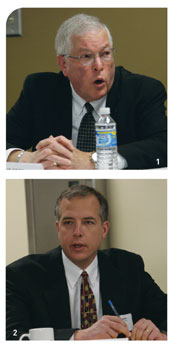Steve McDowell spoke of a concerted effort made seven or eight years ago to address this very problem. “Some of the problems were fixed,” he noted, “and it sounds like there is a new set of problems.”
“If every contractor and architect in this room treated our customers like the city treats us,” said Ernie Straub, “we wouldn’t have very many customers.”
“We’ve had the best luck,” countered Mark Hoffey. “We have a couple of individuals who know how to push the system down there. That’s what you’ve got to have. You’ve got to be almost in their face every day.”
Fogel saw the problem not so much as the codes themselves as the people who interpreted them. “The codes are very specific,” he argued. “There’s not a lot of room for interpretation. Yet, not just in Kansas City, MO, but in every municipality, we’ll have one occurrence on every job where someone will try to [reinterpret the code].”

1: Doug Fogel of Fogel-Anderson Construction reports that challenges working with city employees oftentimes exceed the difficulties associated with code compliance.
2: A.L. Huber Construction President Phil Thomas reports on the success his organization has achieved working with certain area cities, particularly on fast-track projects.
Mark Sherwin of RED Development only half-joked that if he and his colleagues give themselves a year for a retail project on a building site, and If they spend nine months waiting on permits, “That doesn’t gives us too much to build it.”
The group was asked if there were any cities that performed particularly well in the permitting process. Don Greenwell volunteered “Shawnee.”
“I would have to agree,” said Fogel. “They’ve got the guidelines; they follow them every time. Our experience in Blue Springs has been very positive. Those are two cities that are cut and dry, pretty standard.”
Phil Thomas talked of his success in Olathe on projects that had to be fast-tracked. “They had the attitude that they wanted the projects in their city and wanted them to happen,” said Thomas. “We would sit down and talk about the timeline and how as a team we would make it.”
On certain model projects Kansas City, Missouri has also performed well. Ernie Straub asked whether the industry could somehow meet with the city “and see if we can’t fix what’s broken.”
“As an industry,” said Tom Saul, “we’ve always been able to solve our problems. We need to form a committee, address it, come up with suggestions, and whether it’s the minority participation or the permitting process, use our organizations like the Builders’ Association and the clout the Builders’ Association has to solve problems.”
Fogel suggested a more indirect approach. “City government,” he contended, “no matter what city, is not going to pay attention to any issue until it gets to the Star.” He added that if the public knows that hundreds of million of dollars of work sat undone and untaxed, they would not be pleased. “But it’s got to get publicized.”
Having moved to Kansas from California, Greg Nook was not optimistic that the problem would get better any time soon. “There is going to be more specific requirements put on projects as we go forward,” he noted. He cited specifically energy guidelines that will come down in the very near future.
Jim Calcara was more optimistic. He related how when his and the other participating firms started the H&R Block project, City Manager Wayne Cauthen brought all the city personnel into one room that would have some impact on that project, and “basically told that group that H&R Block is your client, they’re not your enemy. If you’re going to serve your client, what do you need to do to make the process faster?” “The attitude, the political will, the leadership has to come from the top,” added Calcara.
(...continued)